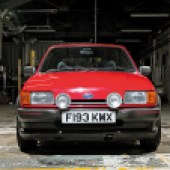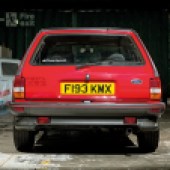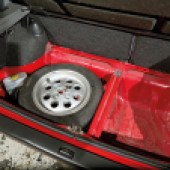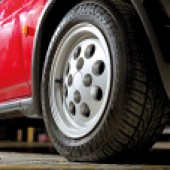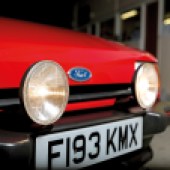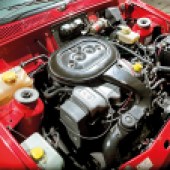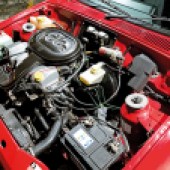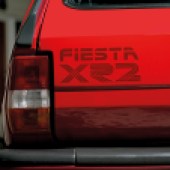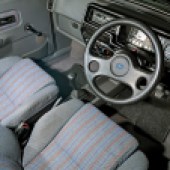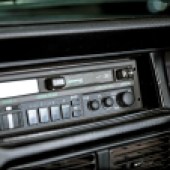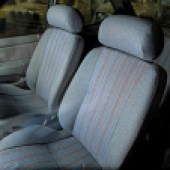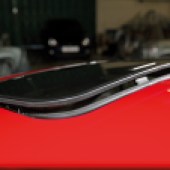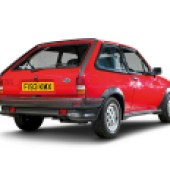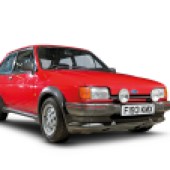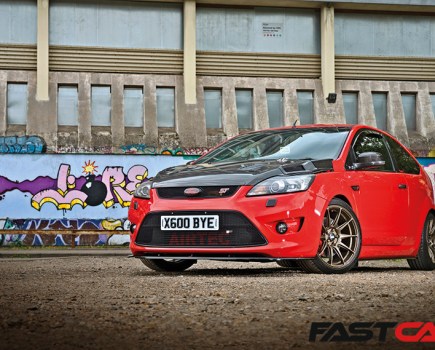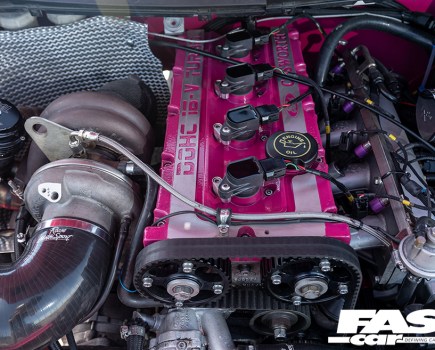Modern STs might be the best-ever Fiestas, yet none can compete with the cool factor of the Ford Fiesta XR2 Mk2 – a quick and chuckable hot hatch with chunky looks, everyday enjoyability and buckets of investment potential.
Ford Fiesta XR2 Mk2 history
August 1983 – Fiesta Mk2 launched as a facelift of Mk1, now with rounded bonnet and headlamps, wrap-around bumpers, new dashboard and cabin, plus revised suspension, steering and brakes.
April 1984 – Ford Fiesta XR2 Mk2 begins production in Valencia, Spain, based on Fiesta Mk2 but with XR3-type 1.6-litre CVH engine and five-speed manual gearbox, uprated suspension, and full bodykit (comprising front and rear spoilers, wheelarch extensions and side skirts).
June 1984 – Fiesta XR2 Mk2 introduced in UK with Rainbow cloth trim and 6x13in steel wheels. Optional extras include alloy wheels, sunroof and tinted glass. Body colours are Diamond White, Sunburst Red, Black, Glacier Blue or Strato Silver.
October 1984 – Rounded roll-top-type front headrests replace dog-eared shape, and seat-back map pockets are deleted. Rosso Red replaces Sunburst Red; Paris Blue replaces Glacier Blue.
December 1984 – Nimbus Grey becomes available.
January 1986 – Digital self-seek stereo radio/cassette player now standard.
February 1986 – Front wing-mounted indicator side repeaters now standard.
September 1986 – Dark grey (Raven) Rainbow cabin is swapped for Shadow (pale grey) Monaco, with rear seat belts now standard. Black steering wheel and dashboard trim replace grey. Centre console-mounted boot release is deleted. Crystal Blue replaces Glacier Blue; Mercury Grey replaces Nimbus.
November 1986 – Lean-burn 1.6-litre CVH introduced, with revised cylinder head and Weber 28/32 TLD carburettor in place of original 32/34 DFT; emissions and power output are reduced; gear ratios are revised to suit.
January 1988 – Tilting/removable glass sunroof and remote-control passenger door mirror fitted as standard.
September 1988 – Tasman Blue replaces Crystal Blue.
December 1988 – Fiesta Mk2 production officially discontinues at Valencia.
February 1989 – All-new Fiesta Mk3 is launched to replace Mk2.
Why you want a Ford Fiesta XR2 Mk2
- Few Fords can match the cool factor of a Mk2 XR2. Even a three-door Cossie or Mk1 Mexico gets no more admiring gazes than the hot 1980s’ Fiesta.
- Funky retro styling, seat-of-your-pants steering and roller-skate handling make for massive fun factor.
- For sheer investment potential, very little else – even in the Ford world – can match an XR2 Mk2, as XR values begin to catch up with those of Rallye Sport models.
Why you don’t…
- XR2s might feel fast, but that’s only due to the feedback from unassisted steering and rattle-tastic plastic cabin. You need to hammer the stodgy gears and rev that asthmatic CVH to keep up with a modern oil-burning crossover.
- Although a Mk2 Fiesta is a perfectly practical car for short commutes, the thrill of a B-road blast to work is negated by worrying about theft and door dings from the company car park.
- Finding a good XR2 is deceptively difficult. Rot is a constant spectre, loads have been wrapped around trees, and far too many have been reshelled into lesser-models’ bodies.
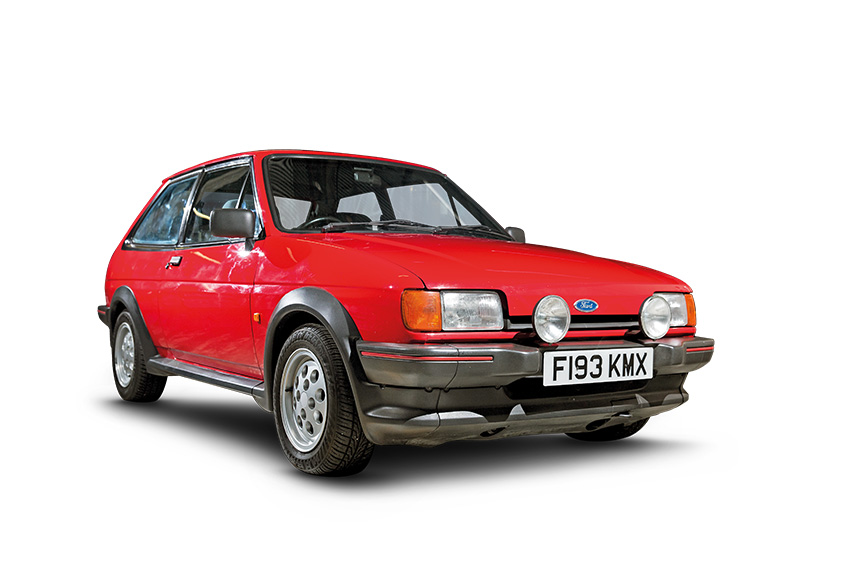
Ford Fiesta XR2 Mk2 Key points
- Exterior – A rotten Mk2 can be a bank-emptying nightmare. Make sure the bodywork isn’t rotten to the core.
- Interior – An XR2 with clean interior trim is most desirable, so ensure all the correct pieces are there, in the correct colour. Mint replacements are pricey.
- Engine – CVHs tend to smoke and rattle, but thankfully don’t cost loads to fix. Make sure the bottom end isn’t knocking and that it’s not breathing from the oil filler cap.
- Suspension – Roller-skate handling should be taken for granted. Vagueness usually points to worn out springs, dampers or bushes, but could be concealing something more sinister.
- Identity – Worrying numbers of XR2s have been reshelled and replicated. Determining a pukka XR2 shell from that of a Popular isn’t easy, so do your homework and ask an expert.
Ford Fiesta XR2 Mk2 Prices
Project: £3000-£6000
Complete rot-boxes and bags of bits could cost you less, but any genuine XR2 shell with logbook will be £3k-upwards. Pay more depending on bodily condition and the number of decent components included in the price.
Good: £6000-£10,000
Pay as much as you can afford for a runner with current MOT – although it may still need work. Even a road-legal car could be hiding horrors. For this money, it’s vital to ensure it’s a real XR2 and not a bodged-up Popular.
Concours: £10,000-£14,000-plus
In this bracket there are more potential buyers than cars available, so expect to spend on a rust-free XR2 with decent history – either all-original or restored to factory-standard. Ultra-low-mileage concours cars easily break the £20,000 barrier.
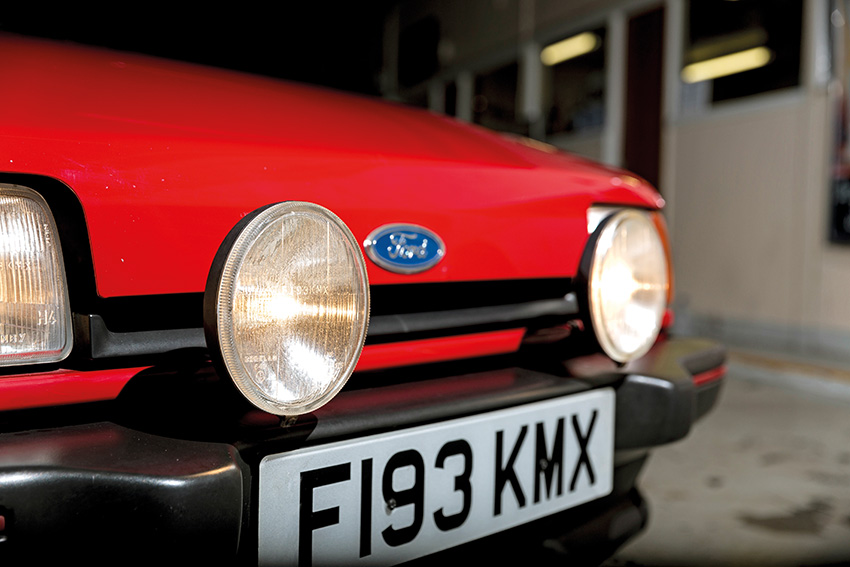
What to look for on the Ford Fiesta XR2 Mk2
Identity
Fake XR2s are disturbingly common. And although some folk may argue (often with vitriolic conviction) that using a second-hand Popular body to ‘reshell’ an XR2 is acceptable, it’s neither legal nor likely to retain the pukka XR’s value. Reshelled cars are simply worth less than Fiestas that left the factory with an XR decal on the tailgate.
To make matters worse, many honest-looking cars were faked or built during the car crime epidemic of the 1990s, so the evidence by now is blurred.
It’s crucial to ensure the chassis numbers match between logbook, VIN plate in the engine bay, and the floor beside the driver’s seat (under a flap in the carpet). Any signs of a ground-off or plated-over chassis number should be a nudge to run away, as should evidence of a previous registration number being polished off the windows.
All XR2s were built on Ford’s Valencia production line alongside lesser models, and the bodyshells were identical apart from the rear valance – on an XR2 it has a bulge to allow a 6x13in wheel and tyre to be stored in the spare wheel well. The XR2’s bodykit hides this bulge, so you’ll need to check from inside the wheel well.
If you’re viewing an especially early car, bear in mind all A-registration XR2s had fewer slots in the windscreen scuttle panel than later Mk2 Fiestas, along with minor differences in the plastic bodykit and rear spoiler.
Although they’re by now often rusty, it’s worth examining the wheelarches beneath the extensions, which were factory-pressed for fixings; the rears were also usually rolled to accept wider wheels. All Mk2 XR2s had a unique steering rack, with lock stops to prevent the 185-section tyres from catching on the wheelarches; be suspicious if the inner wings show shiny metal where the tyres have rubbed.
Finally, check the date stamps on the wheels – an authentic machine should have rims that tally with the car’s build date.
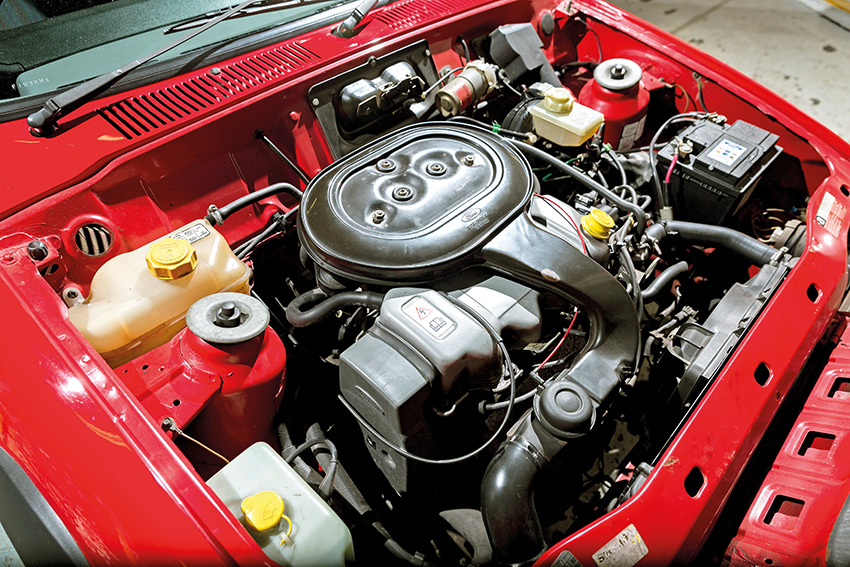
Engine
CVH engines are considered very harsh, but are nevertheless torquey and reliable – as long as they aren’t neglected.
The cambelt should be refreshed every 36,000 miles (or straight away, if the car lacks adequate service history). Crucially, the oil needs to be renewed every 3000-to-6000 miles or at least annually. If not, the oil gums up, and by 60,000 miles the CVH will be tapping from the top end – usually due to dry hydraulic lifters but equally common to be caused by camshaft wear. Heavier knocking – from the bottom of the engine – suggests worn out crank bearings and the need for a full rebuild.
Oil starvation due to leaks is equally likely to destroy a CVH, which tends to drip from the cam cover gasket; look for old oil splashed around the engine bay.
It’s vital to keep the breather system clean, so check the pipe that runs between the sump and cam cover, which blocks up with congealed oil, jamming the oil pickup pipe and wrecking the engine when it’s starved of oil.
A blocked breather system can cause a CVH to blow air out of the oil filler cap with the engine running, but beware it’s not actually escaping past the piston rings, which would tend to accompany poor performance.
Piston ring failure (with requirement for a rebore/rebuild) also tends to puff blue smoke out of the exhaust under load. A few clouds at start-up or on the overrun are less serious, generally pointing to tired valve stem seals, which are cheap to fix. White smoke suggests a failed head gasket, so look for oil in the header tank or mayonnaise on the dipstick.
General poor running is often due to an ageing ignition system (particularly a dodgy distributor); refreshing the components is cheap and easy. Carburettor problems are also troublesome. Repair kits for Weber carbs are inexpensive and freely available, but the carb may simply need to be adjusted. Later-model Mk2s (from autumn 1986) had a 28/32 TLDM (round) instead of the earlier 32/34 DFT (square), which makes less power but tends to be smoother to drive; if not, it’s most likely suffering from a sticky flap.
Finally, look out for an XR2 with dealer-fitted Turbo Technics conversion; it won’t set the world on fire, but it’s a nice kit and worth the extra cash.
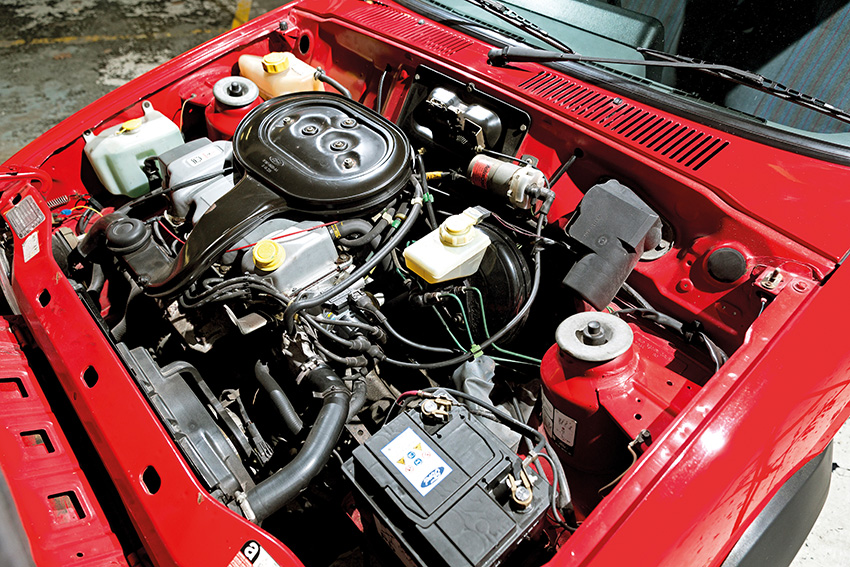
Transmission
Mk2 XR2s had a BC five-speed gearbox, which was more economical than the old four-cog unit, but not as slick to use.
Although it may feel vague and rubbery, it should never be sloppy – typically due to a tired linkage – or notchy. Difficulty selecting gears is a worry if accompanied by crunching, especially between first and second or second and third; this points to synchromesh failure and the need for a rebuild.
If it jumps out of gear, the cause is probably a knackered selector, which also means you’ll need a new ‘box. Likewise, excessive noise: whining tends to mean bearing/output shaft failure; rumbling in fifth suggests worn input shaft splines; louder growling is typically due to collapsed mainshaft or differential bearings, especially if the speedometer is fluctuating or inoperative. Speedo drive faults can also be caused by a broken plastic gear inside the ‘box; either way, the gearbox needs replacing or rebuilding. Clicking from the front with the steering on full lock means a CV joint is tired, which is an easy fix.
Refurbishment isn’t especially expensive, but remember that the final drive ratio was lowered from 3.58:1 to 3.84:1 in autumn 1986, and the later setup improves acceleration.
The stock XR2 clutch is tiny (190mm) and won’t take lots of hard launches. Check it’s not slipping by setting off in second gear; if the car stalls, the clutch is fine.
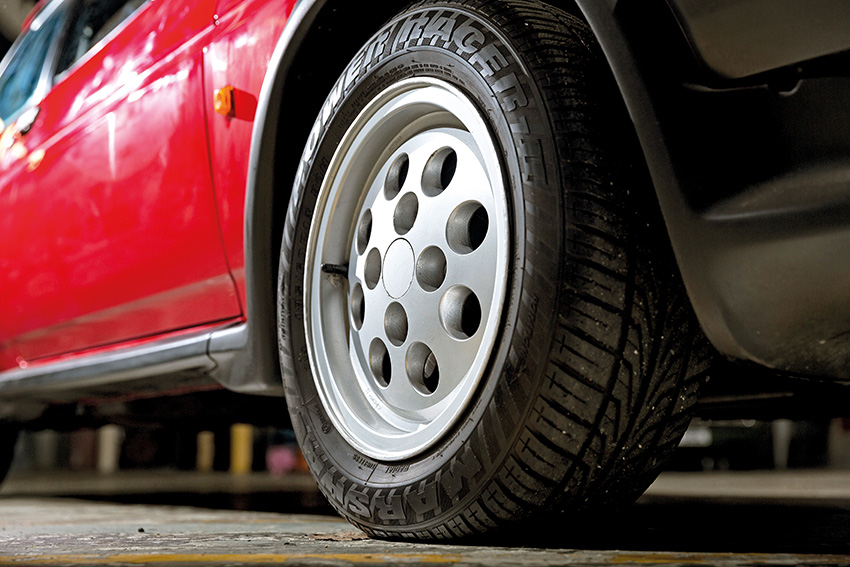
Suspension & Brakes
Nothing fancy, the XR2 suspension differed little from the stock Mk2 1.3, including 14mm rear anti-roll bar, but with 10mm lowered springs and Girling monotube dampers.
Sharp and go-kart-like in period, most XR2s have since had the suspension renewed with inferior items or left to wear out. Sogginess and bounciness say something’s knackered or simply not good enough.
Generally, tired springs and shock absorbers lead to wallowy handling, but wandering at speed suggests the suspension bushes are knackered, especially in the track control arms and front tie bars. Polyurethane replacements are the answer.
Clonking is also fairly common; again it may be due to bush failure, but could come from a snapped coil spring, failed lower ball joint or track rod end.
Beware of noises from the back, which could be caused by broken links or bushes, but may also result from a rotten rear spring cup, which is tricky to fix.
The XR2 has no power-assisted steering, you’ll feel every bump in the road, and you’ll have to peddle hard to make progress. That’s all part of the experience. But sloppiness in the steering says the rack is worn; it’s a regular Mk2 Fiesta component, albeit fitted with lock stops to prevent the 6in-wide wheels from rubbing on the arches; the racks aren’t available new, so will need to be refurbished.
XR2 brakes were adequate when new, but you may be surprised how poor they are by modern measures. The front discs are prone to juddering – felt through the brake pedal and steering wheel – due to warping and contamination, but are fortunately cheap to replace. Even the front callipers, if pulling to one side, can be picked up from your local motor factor.
The rear drums work well only when fastidiously maintained; otherwise they’ll tend to leak from wheel cylinders or fail on the handbrake cable. Jack up the car to check. Note that XR2 cylinders are larger than regular Mk2 Fiesta parts, at 20.6mm rather than 17.5mm.
Underneath, look for rusty brake pipes or ballooning hoses – a sign of neglect. Check for leaks from the master cylinder, and note its location; from autumn 1986 there was a revised brake servo with short black master cylinder to make room for the later model’s ignition module.
Don’t assume an XR2 should have alloy wheels. Pepperpot 6x13s were always an optional extra, although often specified and frequently supplied in place of standard steel wheels. Neither choice adds value to an XR2, but steels and mint trims are unique to the Mk2 and very hard to source.
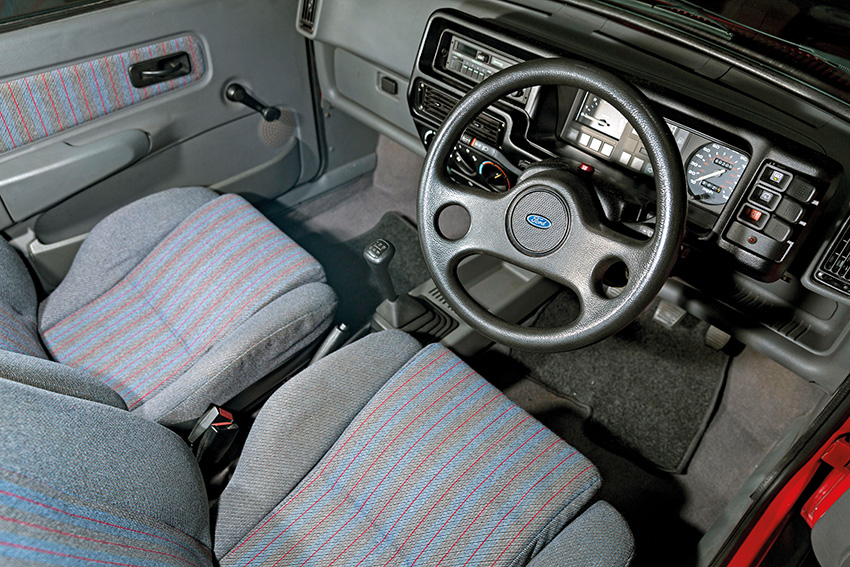
Interior
It’s basic, and all the better for it. But the XR2’s cockpit is also plasticky and prone to rattles. It’s all part of the classic appeal.
XR2 dashboards don’t tend to crack, but may be scuffed or drilled for extra dials; they’re the same as other high-level Mk2s, so not hard to replace. In contrast, the seats and door cards are very tough to source – and impossible to find as new old stock.
Early Mk2 XR2s were fitted with Raven (charcoal-coloured) Rainbow cloth upholstery, with grey dashboard and steering wheel. Later models featured Shadow/Bluestone (pale grey) Monaco trim, mated to black dash and steering wheel. Seat bolsters are prone to sagging, frames can fail, the material tends to tear, and stitching comes apart on the rear bench. Monaco upholstery is also particularly susceptible to dodgy-looking stains.
Bear in mind very early cars had different front seats from later-1984 examples (with map pockets and dog-eared headrests), which are exceptionally hard to find.
Beware of door cards with lifting vinyl or extra speaker holes. Likewise, knock off some cash if the rear parcel shelf has been cut or is sagging; the shelf was fitted to many Mk2s but is nevertheless tricky and expensive to find in mint condition.
XR2s had a unique perforated grey headlining, so be suspicious if it’s not present or appears damaged.
The switchgear was identical to lesser Fiestas – and simple to replace – although the digital clocks of early cars are rare. Rev counters can be erratic, and only the XR2 had a 140mph speedometer. Fortunately, they’re not rare.
Electric windows and central locking weren’t offered from the factory, but could be specified as Ford dealer accessories, so don’t be deterred if you’re determined to find a concours car.
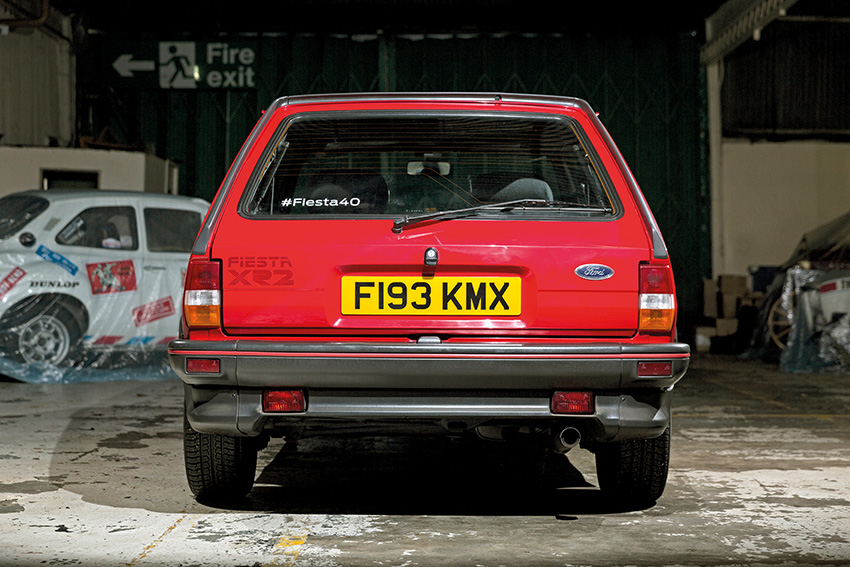
Exterior
Rust? Of course – there’s plenty. The Fiesta is a feast for tinworm, and the XR2 often seemed to suffer worse than regular Mk2s – perhaps due to muck gathering behind the bodykit, or possibly thanks to the type of owners it attracted.
Although it would be rare today to reduce an XR2 to scrap, a severely rotten body can cost more to restore than its overall value. So inspect every orifice with a torch, lifting the carpets and footwell kick-panels to feel for damp, and removing trim wherever the owner will allow.
Notable rot spots include the bulkhead, inner wings (particularly behind the suspension turrets), battery tray, slam panel, bonnet, A-pillars (back in the day, owners often stuffed filler into the lower sections), front wings, windscreen scuttle, door bottoms and inner edges, tailgate, rear quarters (notably around the fuel filler), inner arches, floorpan (especially the chassis rails and in front of the petrol tank), boot floor (particularly the corners and around the drain plugs), sills and wheelarches (behind the bodykit, which tends to cling into place and cover corrosion).
Although any Mk2 could be rotten, the worst were built during 1986 and ’87. Survivors today are rare, and have typically been restored.
Pattern body panels are easy to buy off-the-shelf, but new old stock items are becoming very sought after and expensive.
Don’t be concerned if an early XR2 has no sunroof, because although it was almost always specified, it was a factory optional extra until 1988; it also tended to drain rainwater directly into the sills, leading to severe rust. Tinted glass was a much rarer optional extra, and now very difficult to source.
Decent second-hand bodykits are relatively plentiful, but NOS parts are almost impossible to find; if you’re building a concours XR2, you’ll need to get very spendy.
Similarly, the correct Carello driving lamps and genuine brackets are pricey. You may also find they’re not working, but that’s more often due to the typical Ford problem of faulty earths – and the Mk2 is particularly susceptible to intermittently working lights, with the rears flashing the brakes every time the indicator is operated. Cleaning up and refitting is the free solution.
Guide from Fast Ford magazine. Words: Dan Williamson.
Tech Spec: Ford Fiesta XR2 Mk2
Engine:
1596cc four cylinder eight-valve CVH, cast iron block, alloy head, 9.5:1 compression ratio, single overhead camshaft, Weber 32/34 DFT (pre-autumn 1986) or 28/32 TLDM (autumn 1986-on) twin-choke carburettor, Ford contactless electronic ignition
Transmission:
Front-wheel drive, BC five-speed manual, 190mm single-plate clutch, final drive ratio: 3.58:1/3.84:1 (pre-/post-autumn 1986)
Suspension:
Front: MacPherson struts with Girling monotube gas dampers, 115lb 10mm lowered and uprated springs; rear: beam axle with telescopic Girling monotube gas dampers, lowered and uprated 134lb springs), Panhard rod, Fiesta 1300 14mm anti-roll bar; unassisted rack-and-pinion steering
Brakes:
Front: 240mm ventilated discs and Ferodo pads; rear: 178mm drums with Ferodo shoes; dual-circuit braking system with vacuum servo assistance
Wheels & Tyres:
6x13in steel wheels with hubcaps and 185/60HR13 tyres; optional 6x13in 6x13in Wolfrace Sonic 12-hole (pepperpot) alloys
Exterior:
Fiesta Mk2 three-door hatchback, black front and rear spoilers, rear valance, side skirts and wheelarch extensions, red bumper inserts, front driving lamps, single tape coachline, blacked-out window surrounds, tailgate wash/wipe, twin rear fog lamps, twin door mirrors (driver’s side remote, plus passenger side remote on later models). Optional removable/tilting glass sunroof (standard from 1988) and green-tinted windows. Colours: Diamond White, Sunburst Red, Rosso Red, Radiant Red, Black, Glacier Blue, Paris Blue, Crystal Blue, Tasman Blue, Strato Silver, Nimbus Grey, Mercury Grey
Interior:
Cloth seats (Rainbow cloth on early cars; Shadow Monaco from autumn 1986), soft-feel two-spoke steering wheel (grey on pre-autumn 1986 cars; black on later models), 140mph speedometer, rev counter, digital clock, MW/LW radio/cassette player (digital stereo standard from January 1986), intermittent windscreen wipers, perforated grey headlining. Early models (until autumn 1986) had centre console with cassette storage and remote tailgate release


